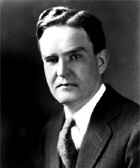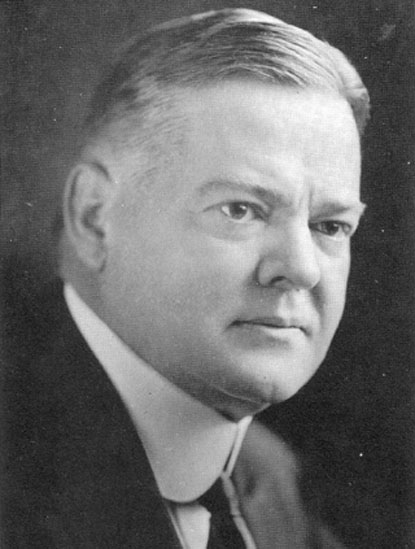I) Minimize federal government intervention in the economy
A) Treasury Secretary Mellon – persuaded Congress to halve the income tax for the top bracket of taxpayers, and drastically lower the inheritance tax (1926)
B) Federal government and railroads – in 1920, the federal government returned control of the railroads to private hands
II) Presidential politics in the 1920s
A) Warren G. Harding – last, and least, of the Ohio presidents; former newspaper editor from Marion, filled appointments with cronies from Ohio, known as the “Ohio Gang,” who looked to line their own pockets
.
1) “Normalcy” – (demonstrates the Bush is not our first English-challenged President; Harding in fact made up this word) Harding’s term for returning the country to normal—conditions back to some idyllic period before the class and race strife brought on by the unprecedented US involvement in a foreign war.
2) Teapot Dome Scandal – Secretary of Interior Albert B. Fall, allowed private companies to drill at an oil reserve called Teapot Dome in Wyoming, secretly, after receiving “loans” from oil company executives.
3) Harding dies in office – after contracting food poisoning on the west coast. He had a hero’s funeral, but almost immediately afterward the stench of scandal from his administration lingered on over much of the next decade.
B) Calvin Coolidge – the solidity of Coolidge, and his personal lack of color, allowed him to distance himself from the scandals of the Harding administration, which he was part of.
1) 1924 Election – Democratic party badly divided; Southern Democrats continued to support Prohibition, and refused to denounce the anti-Catholic and anti-Jewish KKK, while the northern branch of the party wanted former NYC mayor, NY governor, and Catholic Al Smith; after a record 103 ballots, compromise candidate Wall Street lawyer John Davis selected.
(a) “Young Bob” LaFollette and the Progressive Party – painted as a dangerous radical by Coolidge campaign
(i) Proclaimed the “Greatest issue is the control of government and industry by monopoly capital”
(ii) Nationalization of railroads and water power
(iii) Ban labor injunctions
(iv) Increase aid for farmers
(v) Restructure tax system to benefit working people
(vi) LaFollette was able to poll one sixth of the popular vote
2) Coolidge as a reflection on dominant ideology
(a) Bruce Barton and The Man Nobody Knows – ad-man Barton portrayed Jesus Christ as a successful business man (which he considered a compliment).
(i) This provided a way to reconcile new societal mores with America’s fundamentalist Protestant past.
(b) New importance of consumption – the “first importance to his country is no longer that of a citizen but that of consumer. Consumption is a new necessity.”
(c) Reaction – Sinclair Lewis, in his novel Babbitt, decried the standardization and routinization of everyday life; that nationally advertised brands became the standard of excellence merely because everybody had heard of it.
3) Coolidge era foreign policy – “in these days of competition . . . capital . . . and statecraft go hand and hand.”
(a) Pax Americana – the creation of a new world order that would bring stability and allow for expansion of American capitalism.
(b) Foreign policy “successes”
(i) Negotiated end to the naval arms race (UK and US limited to 500,000 tons, Japan 300,000—but Japan was only interested in maintaining a one-ocean navy).
(ii) Dawes Plan – reduced the reparations that Germany was required to pay; country at that time was suffering from runaway inflation.
(c) Industrial foreign policy
(i) In 1929, eight US automobile manufacturers were running factories in foreign countries (including Ford in England); high tech companies of the time (GE, International Telephone and Telegraph, Western Electric) had created an international communications system.
(ii) Exploitation of under developed countries
(iii) Venezuelan oil
(iv) Chilean copper
(v) Cuban Sugar
(vi) Central American fruit (Smedley Butler reminder)
(d) Immigration policy – after years of anti-immigrant agitation, widespread restrictions on immigration are put in place.
(i) 1924 Immigration (Johnson-Reed) Act – restricted total immigration to 165,000/year; also set quotas pegged to the 1890 federal census ethnic totals in a conscious attempt to exclude as many eastern and southern European peoples as possible (Italians had averaged over 200,000/year in 1900s, but were limited to less than 4,000 after 1924)
(ii) Barred immigration completely from people who were ineligible for citizenship (Asian Indians, Chinese, and Japanese)
(iii) Did not restrict immigration from countries from the Western Hemisphere, so the migration of farm laborers (and industrial workers) from Mexico and laborers from French Canada continued unabated.
C) Herbert Hoover – a competent administrator who became overwhelmed by circumstances, and who lacked the vision to overcome those circumstances.
1) 1928 Election
(a) Democratic Party – splits again over the Presidential candidate; this time the northern half of the country prevailed and Alfred Smith, the Catholic, was nominated; his anti-Prohibition stance did not play well in Peoria, however—or anywhere else outside of the large metropolitan centers, and Smith suffered an overwhelming defeat; because of his stance on alcohol and this Catholicism, he could only carry the six Deep South States.
D) Automobile Industry– by 1929, 50% of American families owned an automobile, and the industry directly employed 375,000 people—with millions more indirectly employed because of it.
1) Fordism – Ford’s contribution to the automotive industry was his drive to reduce the cost of the automobile, so that it would become more widely accessible to the general public; Ford accomplished this by increasing the number of specialized machines used to create parts for the automobile. This had two advantages: it decreased his reliance upon skilled workers, who could demand higher wages; and it allowed him to set a specific pace of manufacturing, rather than letting the workers set their own pace
(a) Model T – extremely limited choice (it came with no options, and in one color—black), but this allowed Ford to perfect its manufacture—which in turn allowed Ford to drop the price of the automobile from $950 when it was introduced in 1909 to $290 at the height of its popularity in 1924; by 1919, every other car bought in the United States was a Model T (one out of two).
(b) $5 a Day – the famous $5/day wage, instituted in 1914, was approached by few workers, but it helped limit the turnover of 300%; the higher overall wage also allowed workers to purchase the product that they were manufacturing (analogy to Bush directives for Americans to do their “patriotic duty” and purchase stuff in reaction to Sept. 11)
(c) Increased mobility – ownership of an automobile allowed many more people to move to the suburbs (or “into the country’--or, as we see, out of the South and to the North and the West Coast); also created a greater demand for recreation—along with more workers employed in routinized labor.
2) Sloanism – named after the President of the General Motors Corporation, Alfred P. Sloan. Sloanism is in many ways the perfection of Fordism; automobiles were provided in a variety of styles (kind of), and a variety of price ranges, with advertising aimed at creating a want (or “need”) for a new replacement at regular intervals.
(a) Creation of the General Motors Acceptance Corporation – GMAC created in order to provide financing for potential automobile purchasers who could not pay cash for an automobile.
(b) Triumph of Sloanism – by 1927, falling sales of the Model T forces Ford to shut down production, and re-tool for the production of the Model A. In 1924, Ford had commanded 55% of the new car market.
(c) Increased importance of advertising – used to help people differentiate between largely undifferentiated products; advertising allowed companies to manufacture desires in their customers.









No comments:
Post a Comment